The dong is the official currency of the Socialist Republic of Vietnam. Its ISO 4217 code is VND and its symbol is ₫, always written just after the amount.
Compare rates at 80 currency stores in 34 cities
The word dong derives from the Vietnamese term dong tien, which means money. The term xu comes from the French sous which means “penny”. Each unit of dong is divided into 100 xu.
As of October 2023, the equivalence of the dong currency (note currency, not currency) with respect to the euro is:
- 1 euro = 25,800.37 VND.
- 100,000 dong = 3.87 euros
History of the Vietnamese dong
The dong was born as a currency in 1946, when the communist government of the Viet Minh in the north of the country introduced it to replace the piastre of French Indochina.
A few years later, in 1953, after a final agreement with the colonizing power (France), the independent state of South Vietnam was born. This new country in turn adopted the dong as its own currency, as in its breakaway North Vietnam, although the design of banknotes and coins, as well as the value, were different from that of the dongs of North Vietnam.
Compare rates at 80 currency stores in 34 cities
After the reunification of the country in 1978, under the communist regime, both currencies were merged under the denomination of “liberation dong”, with an equivalence of 1 South Vietnamese dong = 0.8 North Vietnamese dong.
Since then, this currency has suffered successive devaluations due to inflation. Today, the National Bank of Vietnam (SBV State Bank of Vietnam), headquartered in Hanoi, is the only institution authorized to issue Vietnamese dong coins and banknotes.
Vietnamese dong coins
These are the values of the latest series of Vietnamese dong coins in circulation. This series was broadcast in 2003:
- ₫200.
- ₫500.
- ₫1,000.
- ₫2,000.
- ₫5,000.
The national coat of arms of the Socialist Republic of Vietnam appears on all obverses of Vietnam coins. On the two lowest value coins (₫200 and ₫500), which are made of nickel-plated steel, the reverse simply shows the face value.
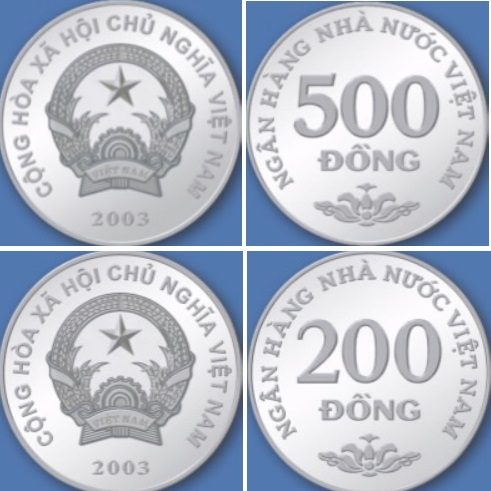
Vietnamese-500-and-200-dong-coins
On the other hand, the reverses of the ₫1,000, ₫2,000 and ₫5,000 coins show some popular monuments and temples of the country: the Water Temple, a typical pillar house of Tay Nguyen and the One Pillar Pagoda of Hanoi, respectively. These coins are made of brass-coated steel and have a tan color.
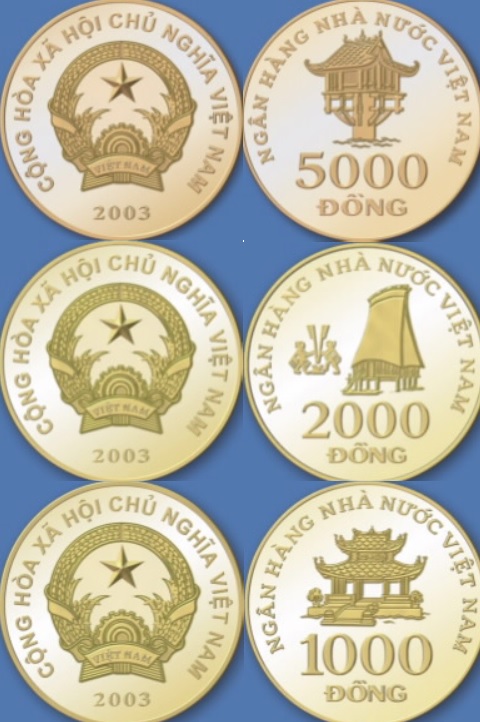
Vietnam-VND-5000-2000-and-1000-dong-coins
The approximate value of the highest value coin in the series (the ₫5,000 coin) is only about 20 euro cents.
Vietnamese dong banknotes
The first banknotes issued in 1978 by the State Bank of Vietnam had a very low face value compared to the current series.
This is due to the effects of chronic inflation that has been dragging on in the country for decades (it reached 453% in 1986), which has recently been more stable. Due to this problem, it is expected that new banknotes with increasingly higher denominations will be put into circulation in the coming years.
The current series, issued in 2003, has the virtue of presenting a uniform design, something that did not happen with previous issues.
Currently, the banknotes of the new series coexist with those of the previous ones, which gives rise to a somewhat confusing situation. The current values of Vietnamese dong banknotes in circulation are:
100₫₫200500₫₫1,000₫2,000₫5,000- ₫10,000
- ₫20,000
- ₫50,000
- ₫100,000
- ₫200,000
- ₫500,000
The 2003 series also involved the replacement of cotton paper with polymer as a material for making banknotes.
On the obverse of all Vietnamese dong banknotes appears the effigy of Ho Chi Minh, the great historical figure of 20th century Vietnam, with an active role as an absolute leader, ideologue and soldier in the communist regime.
Ho Chí Minh (Nguyễn Sinh Cung) was a Vietnamese poet, soldier and insurgent. He was born in Kim Lien on May 19, 1890 and died in Hanoi on September 2, 1969. Between 1945 and 1955 he was prime minister and president of the Democratic Republic of Vietnam (North Vietnam). He was succeeded by Pham Van Dong between 1955-1976.
Banknotes with little circulation
Banknotes of ₫100, ₫200, ₫500, ₫1,000 and ₫2,000 are very rare in Vietnam due to their low face value at the exchange rate. They have practically been completely replaced by coins, although they still remain legal tender.
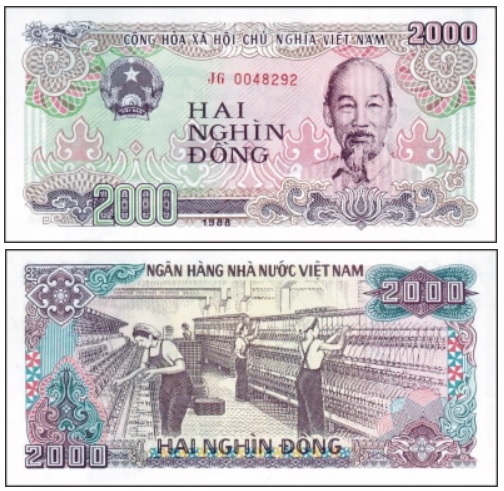
2,000-Vietnamese-dong-VND-banknote
For its part, the five thousand dong banknote is the most popular and abundant of the old cotton paper notes. It is easily recognizable by its intense blue color. On its back the image of the Tri An hydroelectric plant, one of the largest in the country, is reproduced.

5,000-Vietnamese-dong-VND-banknote
Ten thousand dong banknote (₫10,000)
The smallest of the new series of plastic polymer banknotes is the ten thousand dong. It has a brownish yellow color and in the image on the back it is dedicated to oil extraction off the coast of Vietnam.
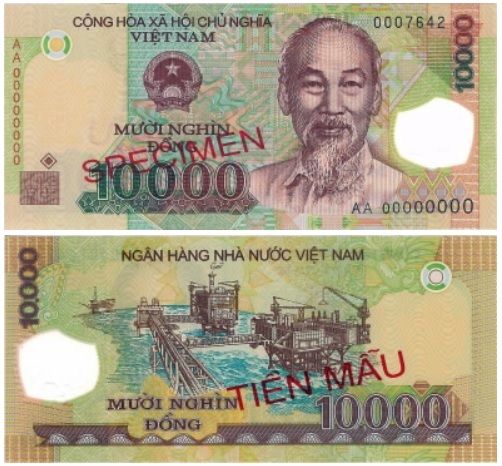
10,000-Vietnamese-dong-VND-banknote
With this banknote, whose exchange value is about 38 euro cents, you can buy, for example, a banh mi, the typical Vietnamese snack sold in street stalls.
Twenty thousand dong banknote (₫20,000)
Blue in color, although in a different shade than the five thousand note, it features on the reverse an image of the Japanese Covered Bridge of Hoi An, a symbol of the fusion of various cultures in Vietnam.
You have to pay attention to the face value of the note, as many foreigners confuse them with the 500,000 dong banknote, which is greenish blue.
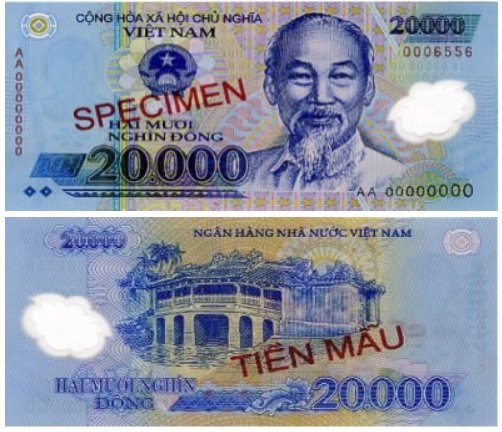
20,000-Vietnamese-dong-VND-banknote
The equivalent value in euros of this 20,000 dong banknote in October 2023 in Spain is about 70 euro cents.
Fifty thousand dong banknote (₫50,000)
The fifty thousand dong note has a very particular pink color that makes it perfectly distinguishable from the rest. On its reverse, an image of Phu Van Lau, a pavilion located on the main axis of the Imperial Citadel of Hue.

50,000-Vietnamese-dong-VND-banknote
Its equivalent value in October 2023 in Spain is about 1.80 euros, enough for a menu in any restaurant in the country.
One hundred thousand dong banknote (₫100,000)
Pistachio green in color, this banknote shows an image of the famous Temple of Literature in Hanoi, one of the most beautiful buildings in the country.

100,000-Vietnamese-dong-VND-banknote
The equivalent value in euros of this 100,000 dong banknote in October 2023 in Spain is about 3.60 euros.
Two hundred thousand dong banknote (₫200,000)
The two hundred thousand dong note has a color that mixes different shades of brown and red. In this case, the reverse shows an image of Ha Long Bay, probably the most visited tourist destination in the country.

200,000-Vietnamese-dong-VND-banknote
The equivalent value in euros of this 200,000 dong banknote in October 2023 in Spain is about 7.20 euro cents.
Five hundred thousand dong banknote (₫500,000)
This is the highest value banknote issued in Vietnam, with an exchange value of approximately 18.5 euros. Greenish blue in color, on its reverse side you can see an image of Ho Chi Minh’s house in Nam Dan, in Nghe An province.
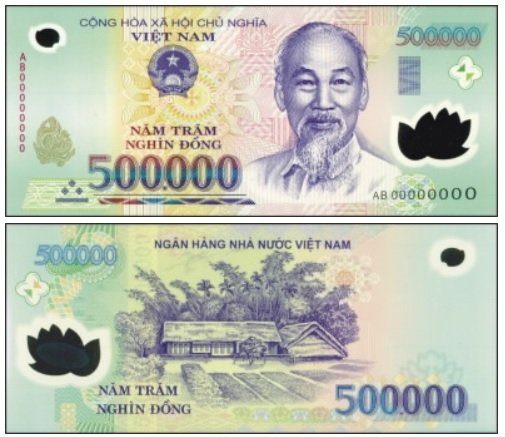
500,000-Vietnamese-dong-VND-banknote
Euro to Vietnamese Dong exchange rate
While it is true that this currency has suffered the punishment of chronic inflation for decades, it should be noted that the exchange rate of the euro against the Vietnamese dong has stabilized quite a bit in the last two years.
If you search on Google for “Euro to Vietnamese dong exchange rate” you will find dozens of websites (“currency converters” like Oanda or XE) that offer a “rate” of the day.
You will also see this graph with the rates of that pair of currencies from Google Finance. Something like this (October 17, 2023):
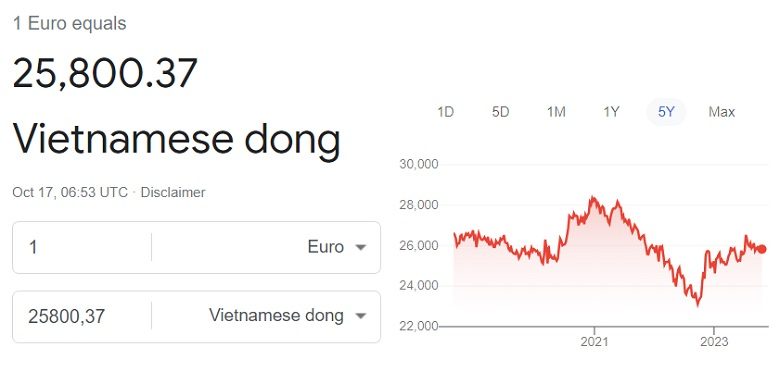
Euro to Vietnamese dong exchange rate 10 2023
As you can see, the exchange rate in the last five years has ranged between 23,983 VND and 28,219 VND for each euro. But keep in mind that this graph represents the value of the Vietnamese dong “currency” against the euro, and not that of the paper currency we use as tourists, which is lower.
In fact, in currency suppliers in Spain you can buy dongs today (October 2023) at an exchange rate of around 22,222 VND per euro from Cambiator or the 17,554.04 dongs per euro that they would give you at airports in Madrid, Barcelona, Alicante or Malaga Global Exchange currency supplier. Nothing to do with the euro to Vietnamese dong exchange rate today of 25,801.81 VND in the foreign exchange market.
So, when you see these values on Google and other currency converters with your mobile, you should keep the following in mind:
-This is an unofficial rate, and therefore not reliable. That is, if you click on the “Disclaimer” link, you get this warning from Google Finance: “Google cannot guarantee the accuracy of the exchange rates displayed. Please confirm current rates before conducting a transaction that may be affected by changes in exchange rates.”
-These rates you see are usually wholesale prices of the Vietnamese dong currency against the euro currency but not banknote rates (currency and banknotes of that currency are not exactly the same).
-These rates can only be had between banks, that is, it is impossible to obtain them as an individual.
If you need Vietnamese dongs in banknotes you will have to go through the retail banknote market (bank or currency supplier). This means that the dongs have had to be “transported” by someone for you to enjoy them (or purchased from travelers from Vietnam, passing through Spain previously).
Furthermore, moving banknotes from one place to another has logistical costs that will make their sale price (the exchange rate that whoever sells it to you apply) more expensive. And there is a risk of depreciation of this currency with respect to the euro, which means that the suppliers have fair stocks.
The Vietnamese dong is not a very abundant currency in Spain. As a result of its scarcity, its price is more expensive in Spain than in Vietnam. If you decide to buy Vietnamese dongs in Spain, it is good to anticipate the purchase and order them online to get a better rate.
Where to exchange Vietnamese dongs
The three most popular places to exchange Vietnamese dongs in Spain are banks, currency suppliers and suppliers at the airport.
Of them, the least advisable place to buy is the airport since today they would give you, for example, about 18,655.84 dongs per euro. For their part, none of the large Spanish banks (Santander, BBVA, Caixabank and Sabadell) sell Vietnamese dongs.
As for the suppliers in Spain, they usually have good rates (except those in airports and AVE stations such as Global Exchange and Exact Change, which have very attractive exchange offices but do not give good rates). The currency suppliers that collaborate with Cambiator do not charge you a commission and when competing between them, you can always hire the supplier that best suits you (by rates, convenience, proximity to you, trust, etc.).
For its part, ING has an agreement with Global Exchange to send the dongs to your home. And Evo with Exact Change to do the same. Neither of them charges you a commission, but, since the bank takes a portion of your change, the dong rates will not be as interesting for you. Check it out yourself.
For example, ING and Global Exchange offer you today, October 17, 2023, an exchange rate of 1 EUR = 21,474.45 VND.
This means that for 1000 euros you would get 21,474,450 dongs, much less than the 22,222,222 dongs you will get with Cambiator.
The difference between one option or the other today is 747,772 dong, about 30 euros at the exchange rate.
Euro to Vietnamese dong exchange today
To know the exchange rate euro to Vietnamese dong and vice versa, the best thing you can do is use our currency comparator.
- Exchange rate euro to dong (EUR-VND)
- Exchange rate dong to euro (VND-EUR)
Other popular currencies
Best rate of the day (exchange euros to another currency)

Sin comentarios